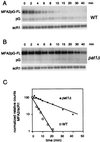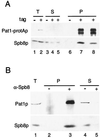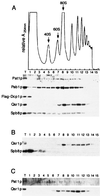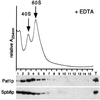The two proteins Pat1p (Mrt1p) and Spb8p interact in vivo, are required for mRNA decay, and are functionally linked to Pab1p
- PMID: 10913177
- PMCID: PMC86071
- DOI: 10.1128/MCB.20.16.5939-5946.2000
The two proteins Pat1p (Mrt1p) and Spb8p interact in vivo, are required for mRNA decay, and are functionally linked to Pab1p
Abstract
We report here the characterization of a bypass suppressor of pab1Delta which leads to a fourfold stabilization of the unstable MFA2 mRNA. Cloning of the wild-type gene for that suppressor reveals that it is identical to PAT1 (YCR077c), a gene whose product was reported to interact with Top2p. PAT1 is not an essential gene, but its deletion leads to a thermosensitive phenotype. Further analysis has shown that PAT1 is allelic with mrt1-3, a mutation previously reported to affect decapping and to bypass suppress pab1Delta, as is also the case for dcp1, spb8, and mrt3. Coimmunoprecipitation experiments show that Pat1p is associated with Spb8p. On sucrose gradients, the two proteins cosediment with fractions containing the polysomes. In the absence of Pat1p, however, Spb8p no longer cofractionates with the polysomes, while the removal of Spb8p leads to a sharp decrease in the level of Pat1p. Our results suggest that some of the factors involved in mRNA degradation could be associated with the mRNA that is still being translated, awaiting a specific signal to commit the mRNA to the degradation pathway.
Figures








References
-
- Beelman C A, Parker R. Degradation of mRNA in eukaryotes. Cell. 1995;81:179–183. - PubMed
-
- Beelman C A, Stevens A, Caponigro G, LaGrandeur T E, Hatfield L, Fortner D M, Parker R. An essential component of the decapping enzyme required for normal rates of mRNA turnover. Nature. 1996;382:642–646. - PubMed
Publication types
MeSH terms
Substances
LinkOut - more resources
Full Text Sources
Molecular Biology Databases
Miscellaneous
